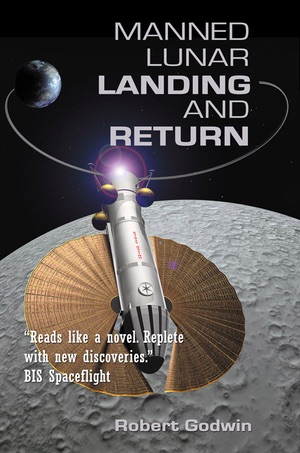Review: Manned Lunar Landing and Returnby Dwayne A. Day
|
| Vought Astronautics, a division of Chance Vought Aircraft Incorporated, began work in 1958 on “advanced” human space flight concepts. |
When we look back at the history of major space events, so much gets ignored. I continue to be surprised—sometimes surprisingly surprised—to discover new aspects of space history that I thought were already well-trodden. A decade ago I stumbled across information about the SNAP-8 nuclear space reactor which amazed me, because in all the books and articles I had read about space nuclear power, I had never even seen it mentioned. And yet a considerable amount of money was spent on it, and test reactors built, but because it did not fly, it was left out of the books. Similarly, the M-1 rocket engine is barely mentioned in any histories of rocketry, and yet a rocket contractor built numerous test stands and engine hardware and began early testing before the project was shut down. (See “M is for Monster,” Spaceflight magazine, July 2016.) Perhaps my favorite example is the Lunar Mapping and Survey System, which was developed as part of the UPWARD program. It was a classified spy satellite camera repurposed to photograph Apollo landing sites, and escaped the history books because it was secret. (See “The Eagle has crashed: the top secret UPWARD program and Apollo disasters,” The Space Review, July 1, 2019.)
Now Robert Godwin has written a new book about a lunar landing proposal before the Apollo program that expands our knowledge of the work that went into Apollo. Vought Astronautics, a division of Chance Vought Aircraft Incorporated, began work in 1958 on “advanced” human space flight concepts, which essentially meant the steps beyond what NASA was then planning for Mercury, including sending humans to the Moon. Vought was then known as a highly successful producer of naval aircraft such as the famed gull-winged World War II-era F4U Corsair and the sleek late 1950s F-8 Crusader. Like all major aircraft manufacturers, Vought wanted to get into missiles, rockets, and spacecraft. And, so, they began researching and testing.
Much of the book is devoted to Project MALLAR (for “Manned Lunar Landing And Return”), Vought’s first lunar mission proposal. But Godwin explains how Vought did not simply issue a single proposal. The company also built a spaceflight simulator and conducted research during the early 1960s on different ways of reaching the Moon. According to Godwin, Vought’s engineers figured out early on that lunar orbit rendezvous (LOR) was the best method for reaching the Moon and focused their efforts on designing a spacecraft that would serve as a lunar taxi to and from a spacecraft in lunar orbit. Godwin notes that although John Houbolt of NASA was a staunch advocate of LOR, Vought had first brought the idea to NASA, and Vought’s engineers were studying it extensively before Houbolt successfully convinced NASA officials that it was the best choice. Godwin writes that he conducted extensive research trying to trace the path of the LOR mission mode to NASA decision makers and concluded that Houbolt almost certainly learned about it from Vought’s work.
| As Godwin’s book demonstrates, a lot of people in a lot of companies were working on similar ideas leading up to the Apollo program, and it’s time that some of their histories get written down. |
Vought also made a great effort to produce a detailed proposal for the Lunar Excursion Module contract. But if you are familiar with the Apollo program, you know that Vought didn’t make it. Grumman built the Lunar Module. North American built the Command and Service Modules as well as the Saturn V’s second stage. Boeing built the Saturn V first stage, and Douglas built the third stage. Vought didn’t get any major Apollo contracts, and in the early 1960s became part of Ling-Temco-Vought. The company did win the lucrative Lance missile contract for the Army. By the late 1960s the company followed its Crusader with its shorter, fatter cousin, the A-7 Corsair attack jet, and continued winning missile contracts. But Vought never made it big in the space business like Hughes, Boeing, Lockheed, or Ford Aerospace. Today, after numerous buyouts, mergers, and reorganizations, the company name still exists as a subcontractor to other major aerospace companies, but it is mostly forgotten.
Vought was not the only major aerospace contractor to make a bid on Apollo only to lose out on the big show. But as Godwin’s book demonstrates, a lot of people in a lot of companies were working on similar ideas leading up to the Apollo program, and it’s time that some of their histories get written down. Manned Lunar Landing and Return is a good start.
Note: we are temporarily moderating all comments subcommitted to deal with a surge in spam.
